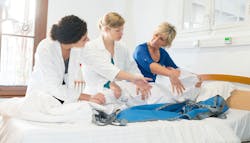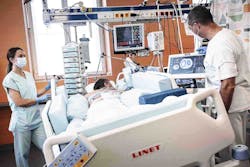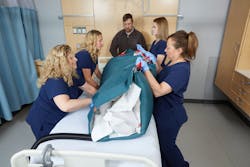Patient care requires many measures in the effort to achieve safety and comfort for every patient. One primary concern, no matter the healthcare setting, is preventing healthcare-associated infections (HAIs), injuries or other complications that can be harmful, or even worse, fatal for those in care.
Addressing staff challenges
Staff must give special attention to patient positioning in order to prevent pressure injuries or other negative outcomes for patients treated in the operating room, an intensive care unit (ICU), or other hospital or medical facility. Several barriers, however, may make the processes of turning or moving patients difficult, points out Brittany Hahn, Marketing Communications Specialist, HoverTech International, Allentown, PA.
“Challenges facilities face include not having the appropriate safe patient positioning devices readily available when needed, insufficient policies and procedures in place, and a lack of adequate training and support for staff on patient positioning,” Hahn indicated. “It’s no secret that healthcare workers are extremely busy, and as a result of that, the use of proper equipment and techniques can be overlooked. The best patient positioning equipment in the world has no value unless it’s being used.”
Caring for COVID-19-infected patients presents unique positioning complications, she added.
“Shortly after the virus spread across the US, it was discovered that proning can be used to optimize oxygenation. Although it can be beneficial for patients, the task of proning poses a high risk of injuries to healthcare workers. In order to perform the task safely, it requires proper technique, equipment, and additional staff to keep everyone safe. The burden for this task is especially heavy given the current need to limit the number of staff in ICU rooms to reduce virus exposure.”
Caroline Marchionda, BSN, RN, a clinical specialist at LINET Americas, Inc., Charlotte, NC, states, “One of the biggest problems we as nurses encounter is that the nurse is usually in the isolation room with no other staff. That makes repositioning more stressful for the patient and nurse. We have found the assistance from the Multicare bed helps to turn patients with its frame-based lateral turn technology. Less staff is needed to care for each patient at a time, which reduces PPE, makes more consistent Q2 hour turns, and makes offloading easier.”
Advancing patient safety
Obstacles with care-acquired conditions
Several national agencies and organizations provide oversight, standards, education and support regarding patient safety, as it remains a high priority in care.
The Agency for Healthcare Research and Quality (AHRQ), part of the U.S. Department of Health and Human Services (HHS), last March released a report that “reviews 47 practices that target patient safety improvement in hospitals, primary care practices, long-term care facilities and other healthcare settings.” 1
Some main topics in the report include:
• “Medication management
• Healthcare-associated infections (HAIs)
• Nursing-sensitive practices
• Procedural events
• Diagnostic errors
• Crosscutting factors”1
The report went on to highlight the persistence and impact of hazards with patients, noting, “Despite sustained national attention and notable successful interventions in recent years, patient safety remains a significant problem in the United States. Harms such as adverse drug events, HAIs, falls and obstetric adverse events are blamed for thousands of deaths and hundreds of thousands of injuries each year. AHRQ statistics estimate that in 2017, there were 86 hospital-acquired conditions per 1,000 hospital discharges – a figure that has fallen steadily in recent years but remains alarmingly high.”1
Successes with pressure injuries
Leading progress in decreasing patient pressure injuries in hospital care is the Joint Commission Center for Transforming Healthcare, which last October announced that, “A collaborative project to address hospital-acquired pressure injuries (HAPI) has resulted in more than a 60 percent reduction in a common but preventable issue that claims over 60,000 U.S. lives each year. Led by the Joint Commission Center for Transforming Healthcare, the improvement initiative — including The Johns Hopkins Hospital, Kaiser Permanente South Sacramento Hospital and Memorial Hermann Southeast Hospital — saw these significant reductions sustained even as the COVID-19 pandemic accelerated in the United States.”2
Pressure injuries pose a detrimental threat to patient health and life as well as costs of care, growing into an even greater challenge during the COVID-19 pandemic, indicated the commission.
“The project launched to identify solutions to prevent and reduce the rate of pressure injuries, also known as decubitus ulcers or bedsores, in healthcare facilities after seeing that HAPI were rising nationally. Experts estimate more than 2.5 million patients in U.S. acute-care centers experience pressure ulcers and injuries each year. Because pressure injuries are a significant risk for immobile patients, the country is experiencing a jump in this condition as COVID-19 patients require long hospitalizations.”2
The commission shared that the three hospitals accomplished not only less pressure injuries, but more savings of costs in care.
“Organizations achieved an average 55 percent relative reduction in intensive care unit pressure injuries from May 2018 to December 2019. They continued building on that momentum from January to April 2020, experiencing a 62 percent average relative reduction and preventing 78 pressure injuries annually. This outcome resulted in a cost savings in aggregate of $15.3 million for the length of the project by reducing an expensive condition that costs the healthcare industry $11 billion a year.”2
Adding prophylactic dressing standards
Bringing to the forefront prophylactic measures are the National Pressure Injury Advisory Panel (NPIAP) and the European Pressure Ulcer Advisory Panel (EPUAP), which last November announced, “the launch of the joint NPIAP-EPUAP Prophylactic Dressing Standards Initiative (PDSI) and the establishment of a dedicated international Task Force to lead and develop this initiative.” 3
The panels stated, “No known standards exist anywhere in the world for prophylactic dressings, despite their international widespread and growing use. Performance standards based on bioengineering laboratory testing generate critical information, which is needed to guide effective medical product selection and practice. Testing standards and consistent manufacturing are established for all types of medical devices and serve different stakeholders in multiple ways, including the industry itself by providing benchmarks for development purposes or instructions for use. Testing standards further serve regulatory bodies and reimbursement policy makers in evaluating safety and efficacy and in qualification of existing and new products for use with patients who have specific needs.”3
Proning and positioning patients
Healthcare teams should work together to use a proning technique to position patients with respiratory ailments, remarked the American Association of Critical-Care Nurses (AACN) last January.
“When research and new clinical guidelines strongly recommend that critically ill patients with severe acute respiratory distress syndrome (ARDS) be face-down for most of the day, the change requires a team approach to integrate the logistically challenging, multifaceted repositioning procedure into clinical practice.”4
The association continued, “ARDS is estimated to be responsible for 10 percent of all admissions to ICUs worldwide and occurs in nearly a quarter of patients undergoing mechanical ventilation. The mortality rate for ARDS remains high, even though patient outcomes have improved significantly in the last decade, from an estimated hospital mortality of 90 percent to a reported 46 percent. Prone positioning is now considered first-line therapy for patients with severe ARDS to reduce lung trauma and improve outcomes. Recent studies show that lying face-down for up to 16 hours a day can improve oxygenation and decrease mortality.”4
As many COVID-19-infected patients experience respiratory conditions and treatment, proning and specialized positioning equipment may be effective in their care.
“COVID-19 patients often need to be in prone position for long periods of time,” Marchionda explained. “Special care must be given to prevent skin breakdown since critical patients are possibly not turned as frequently due to being hemodynamically unstable. Micro-shifting a patient while in prone position, such as laterally tilting one degree at a time with the Multicare critical care bed by LINET, provides pressure redistribution and pressure relief with minimal hemodynamic impact. The Multicare has frame-based lateral turn technology that assists caregivers with daily care, helps with pressure injury prevention, and assists in preventing ventilator-associated pneumonia.”
Proper patient positioning equipment and practice provide dual protection for patients and staff.
“For patient length of stay, the HoverMatt Single-Patient Use (SPU) Air Transfer Mattress and HoverSling Transfer and Lift System, in combination with HoverTech Positioning Wedges, provide a well-rounded solution to protect nurses from musculoskeletal injuries, and patients from friction and shear while supporting pressure injury prevention initiatives,” Hahn indicated. “The HoverMatt SPU and Positioning Wedges comply with NPIAP guidelines for the prevention and treatment of pressure injuries. HoverTech offers the HELP Program, which assists hospitals in assessing and creating a robust Safe Patient Handling and Mobility (SPHM) program.”
“Looking for a solution to prone their patients, a one-thousand bed Magnet Certified hospital in the Southeast turned to the HoverMatt SPU,” Hahn shared. “This resulted in a better approach for patient safety while reducing the risk of muskuloskeltal injuries in healthcare workers.”
Rehabbing at home
After returning home from critical care in the hospital or another setting, patients must maintain movement and continue rehabilitation in their daily activities. This better ensures they will recover well and avoid harmful situations.
The Society of Critical Care Medicine last February reported that, “Home health rehabilitation can help seniors get stronger and resume activities after an ICU stay, yet one in three Medicare patients don’t receive this care, according to a first-of-its-kind study presented at the Society of Critical Care Medicine’s 49th Critical Care Congress.”5
Such care can be vital to preventing patient infections or other serious complications.
The society continued, “People who spend time in the ICU are at risk for post-intensive care syndrome (PICS) or problems that remain after critical illness. One of those problems is ICU-acquired muscle weakness, and people who were admitted for sepsis (a severe infection) or spent a week or longer in the ICU are at increased risk. Rehabilitation is an important part of post-discharge care, which improves the chance of recovery. There are no established guidelines for the number of visits these patients should receive. Most of the patients in the study were homebound, meaning they could not leave the house without significant effort.”5
Other findings from the society include:
• “One in three Medicare patients referred for home health rehabilitation after the ICU don’t receive any services, and those who do get very few visits.
• It can take up to six months for many of these patients to recover function after an ICU stay if they recover at all.
• Those who lived alone or in rural areas were least likely to receive home rehabilitation.
• All patients who spend time in the ICU should be screened for rehabilitation needs, as many will be at risk for post-intensive care syndrome.”
Expanding transfer devices
So, what does the future hold for patient positioning? Lateral transfer is one possible area, as evidenced with Arjo’s last December announcement of its “acquisition of AirPal, a privately owned US-based company specializing in Air-Assisted Lateral Patient Transfer solutions.” 6
Such equipment can be critical to preventing staff injuries and adverse patient care outcomes.
The company continued, “Healthcare has the highest proportion of work-related injuries of all professional groups (of nonfatal accidents). Fifty to 60 percent of all global healthcare professionals are affected by muscular skeletal disorders. Lateral transfers and repositioning are the most commonly cited patient handling tasks reported in healthcare, and when performed manually, jeopardizes both staff and patient health. Using an air-assisted system, such as AirPal, provides a more effective solution to mitigate the physical efforts and injury risks associated with performing lateral transfers, in addition enabling reduced caregiver injuries and healthcare costs. AirPal’s technology releases low-pressure air through perforated chambers in its TransferPad, which is placed under the patient in the same manner as a bed sheet.”6
This market, projected by Arjo, will continue to grow nationally and beyond.
“Today, the US market size for air assisted lateral transfers is estimated at approximately 160 M USD, with an estimated annual growth of five percent. The initial focus is on the US market, followed by UK and Australia.”
References
1.Agency for Healthcare Research and Quality, AHRQ Report Reviews 47 Practices To Improve Patient Safety, March 10, 2020, https://www.ahrq.gov/news/newsroom/press-releases/making-healthcare-safer3.html
2. Joint Commission Center for Transforming Healthcare, Leading Hospitals Partner to Reduce Hospital Acquired Pressure Injuries, October 7, 2020, https://www.centerfortransforminghealthcare.org/press-room/news/2020/10/joint-commission-center-for-transforming-healthcare-leading-hospitals-partner/
3. National Pressure Injury Advisory Panel, Launch of the joint NPIAP-EPUAP Prophylactic Dressing Standards Initiative (PDSI), November 3, 2020, https://npiap.com/news/535315/Launch-of-the-joint-NPIAP-EPUAP-Prophylactic-Dressing-Standards-Initiative-PDSI.htm
4. ICUs Turn to Prone Positioning for Patients With ARDS, Jan. 15, 2019 https://www.aacn.org/newsroom/icus-turn-to-prone-positioning-for-patients-with-ards
5. The Society of Critical Care Medicine, One in three Medicare beneficiaries don’t receive home health rehabilitation after ICU stay, Feb. 16, 2020, https://www.sccm.org/getattachment/About-SCCM/Media-Relations/Press-Release-Abstract-Post-ICU-rehabilitation-FINAL.pdf?lang=en-US
6. Arjo acquires AirPal – a US company focused on patient transfer, December 2, 2020, https://mb.cision.com/Main/12208/3248203/1343458.pdf
About the Author

Ebony Smith
Ebony Smith was previously Managing Editor for Healthcare Purchasing News.


